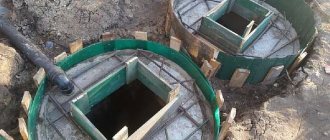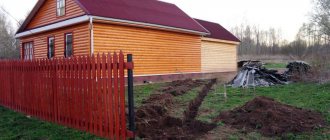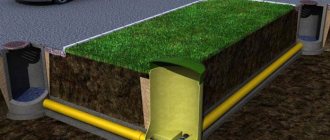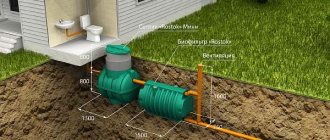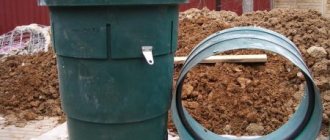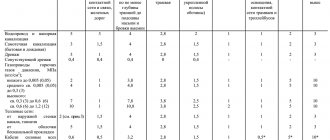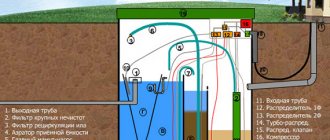Before starting the construction of an autonomous sewer system, it is important to carry out the design stage, during which the location of the system is determined. There are requirements regarding the distance from the septic tank to the house, drinking well, and natural reservoirs.
All requirements are regulated by law and special regulatory documents. Sanitary standards also determine the distance from the fence, neighbor’s property, green spaces and other objects.
If you do not do this, the result will be flooding of the foundation of the house, flooding of the garden and other problems.
Why comply with the rules?
The first and main reason is safety for human health. Hydrogen sulfide and methane accumulate in the septic tank. If there is a breakdown or loss of tightness, groundwater (feeding wells and wells) may be contaminated with untreated wastewater.
In addition, if you violate the sanitary standards for the location of the septic tank and receive a complaint from your neighbors, you may be fined by Rospotrebnadzor for violating the norms of Law 52-FZ of March 30, 1999 “On the sanitary and epidemiological welfare of the population.”
Thank you for filling out the form. Our specialist will contact you shortly!
1
1
- 1
- 2
- 3
- 4
- 5
- 6
- 7
0%
https://vse-septiki.ru/wp-content/plugins/nex-forms-express-wp-form-builder
false
message
https://vse-septiki.ru/wp-admin/admin-ajax.php
https://vse-septiki.ru/sovety/rasstoyanie-ot-septika-do-doma
no
1
- 1
- 2
- 3
- 4
- 5
- 6
- 7
0%
Therefore, they should not be violated. This will not lead to anything good, except fines and, in the worst case, contamination of aquifers.
Standards that can be found in official sources
In 1997, Building Codes and Rules were adopted, which are still used today both in the construction of residential buildings and in the placement of buildings of various types. Regarding wells, there are clear removal standards that can be used when making calculations:
the well must be at least 4 meters away from trees of medium and significant height (this is due to the intensive growth of a powerful root system, which can also pose a threat to concrete; the well ring or building must be kept at a distance of at least a meter from bushes (as required by sanitary regulations). standards so that litter, leaves, and crumbling berries do not get into drinking water; the well must be located at least 50 m away from septic tanks, cesspools, sewer systems and toilets, since closer proximity is contrary to sanitary and hygienic standards and threatens the spread of intestinal infections ; from additional reservoirs of local local sewerage, it does not matter whether they are inspection, nodal or rotary, the distance should be more than 30 m, despite the fact that they themselves should be located at a distance of 15 m from each other; a building for poultry or domestic animals is not can be closer to the well by less than 30 m; the distance to the house is at least 3 meters from the foundation; from outbuildings that do not house animals, the well can be located at a distance of no less than 1 m.
Norms and rules for individual housing construction and SNT
Nuances
All these standards are prescribed in SNiP, developed for small summer cottages. A guideline for determining the optimal distance from the fence can be the distance between the wells. According to the standards, structures with drinking water can be separated from each other by approximately 50 m. These rules apply both within the city and in rural areas or villages for SNT, individual housing construction and private household plots.
But there is one relaxation - if they are installed on different aquifers and construction on one land plot will not cause a decrease in the water level in another, then the distance can be reduced to 30 m.
You can focus either on the standards for a drainage structure, then it will be 4–5 meters to the fence, or on the standard regarding the distance from the neighboring well. Then, no matter how many meters there are to the fence located on an imaginary line drawn between them, the distance will be maintained correctly.
Standards for rural settlements, cities and villages
If everything is endorsed by representatives of local authorities, in any disputes you can safely refer to permission received from people competent and possessing regulatory knowledge. No court will consider claims from neighbors if each building on the site has a permit issued by regional government officials.
What should be the distance from the septic tank to a residential building and other buildings
It is not clearly regulated by building regulations. The closest point of the current rules that you can focus on is SP 53.13330.2019 . It states in paragraph 6.8 the distance between the outhouse or composting facility and a private residential house or other buildings. It must be at least 8 meters.
In the guidelines STO NOSTROY 2.17.176-2015, which is the standard of the organization “Association of Builders”, compiled by the famous author of many books and works on autonomous sewage systems Andrei Ratnikov, paragraph 5.4.3 states that the minimum distance from the treatment plant to a residential building should be accept from 5 meters.
But it is necessary to clarify what we are talking about when the term “septic tank” is pronounced.
Quiz from the page - article pages - one for everyone
Thank you for filling out the form. Our specialist will contact you shortly!
1
1
- 1
- 2
- 3
- 4
- 5
- 6
- 7
0%
https://vse-septiki.ru/wp-content/plugins/nex-forms-express-wp-form-builder
false
message
https://vse-septiki.ru/wp-admin/admin-ajax.php
https://vse-septiki.ru/sovety/rasstoyanie-ot-septika-do-doma
no
1
- 1
- 2
- 3
- 4
- 5
- 6
- 7
0%
Factory flow septic tank
This is an ordinary plastic container consisting of several chambers, where the processes of mechanical settling of wastewater occur, with its decomposition by anaerobic bacteria. A flow-through septic tank requires a soil filtration system (for post-treatment) - this can be a drainage well or an aeration field.
Biological treatment station
Biological treatment plants that operate on a different principle are often called septic tanks. Here, active aeration of wastewater is used to form aerobic microflora. Such structures do not emit foul-smelling gases, and the cleaning process itself is much more intense. But there may be some noise from the compressor.
Get a response within 3-12 hours from a specialist
At the same time, the distance from the filter well to the house in STO NOSTROY 2.17.176-2015, similar to SP 53.13330.2019, is recommended to be at least 8 meters (5.5.2.8).
To summarize, we can draw 2 conclusions:
- If there is an extreme shortage of space, it is possible to reduce the distance between the treatment plant and a private house to 5 m.
- It is extremely undesirable to reduce the distance to less than 8 m for flow-through septic tanks that do not use wastewater aeration due to a possible unpleasant odor.
Other standards for septic tank placement
There are additional rules that, like the distance from the house to the septic tank according to the standards, must be taken into account when creating a sewer system:
- It is better to place an autonomous sewerage system on soft soils: in this case, the work will be simplified, which is especially important when constructing the system yourself;
- When installing a septic tank next to the house, you need to maintain at least a meter of distance from the foundation of any building located on the site, so that a breakthrough in the system does not lead to erosion and subsequent destruction of the foundation;
- The waste collection container must be cleaned periodically, so it is necessary to ensure unimpeded access to it for the sewer truck.
Conclusion
Planning a septic tank on the site must be combined with current regulations. If the sanitary standards for installing a septic tank are met, then the system will work correctly, and the possibility of conflicts in this case is reduced to zero.
Distance from the septic tank to the well or well
Compliance with these standards is especially critical.
Otherwise, a well or borehole may be contaminated with wastewater, which can lead to poisoning. There are no clearly established standards relating specifically to septic tanks and biological treatment stations in this matter. Therefore, we present approximate standards:
The minimum distance from the well to the outhouse latrine is established in clause 6.8
of SP 53.13330.2019 and must be at least 8 m. At the same time, there is another norm prescribed by
SP 42.13330.2011 , where in clause 7.1 it is established that in the absence of a central sewerage system from the toilet to the water supply source must be at least 25 m. Expert opinion
Albert Lyushin
Engineer-technologist with more than 15 years of experience.
Order installation of a septic tank
There is a legal conflict in this matter. In our opinion, a larger value should be used. This is confirmed by the now defunct SNiP 2.04.03-85, where in paragraph 2.2 a sanitary zone of drainage wells of at least 25 m was established.
These figures must be strictly observed specifically in matters of indentation not from the septic tank, but from drainage structures - aeration fields, filtration wells, where partially clarified wastewater is drained after treatment.
The septic tank itself or biological treatment station is a completely sealed structure. This applies to factory models, and not to rings of concrete, which over time allow untreated wastewater to pass into the soil through cracks and joints.
That is, it is permissible to include a lower standard for septic tanks. But it is undesirable to do this, since leaks through pipes and hypothetical accidents are possible, which will lead to contamination of the water supply. Therefore, two conclusions can be drawn:
- The distance from the source of drinking water to the drainage structures must be at least 25 m.
- In exceptional cases, the distance to the septic tank itself can be reduced to 8 m, provided that certified factory sealed products are used.
In addition, according to the recommendations of STO NOSTROY 2.17.176-2015, clause 5.5.1.4, soil filtration systems should be placed downstream of groundwater to water intake structures - wells and wells. This is necessary to minimize the risk of contamination by wastewater.
Quiz from the page - article pages - one for everyone
Thank you for filling out the form. Our specialist will contact you shortly!
1
1
- 1
- 2
- 3
- 4
- 5
- 6
- 7
0%
https://vse-septiki.ru/wp-content/plugins/nex-forms-express-wp-form-builder
false
message
https://vse-septiki.ru/wp-admin/admin-ajax.php
https://vse-septiki.ru/sovety/rasstoyanie-ot-septika-do-doma
no
1
- 1
- 2
- 3
- 4
- 5
- 6
- 7
0%
Septic tank: types and types
A septic tank is a reservoir for receiving and storing waste water from a home. If placed incorrectly, it turns from a useful object into an environmental hazard. Therefore, it is important to remember the SNiP standards regulating the distance from the septic tank to a residential building.
It is necessary to strictly comply with the requirements of sanitary and construction standards. SNiP and Sanitary Norms and Rules are the main documents regulating installation work. To install a filter, you need to obtain permission from the SES. Without this permission, the system will be equated to unauthorized development. The owners of the site may be required to dismantle or impose a fine.
Septic tanks are distinguished by:
- type of operation: storage, with a filtration system, for deep biopurification;
Design of a septic tank with a filtration system
- manufacturing materials: plastic, brick, metal, reinforced concrete;
- location of storage chambers - horizontal, vertical, underground, above ground.
The type is determined based on the planned load. Biological filtration units purify wastewater up to 80%.
The distance from the septic tank to the reservoir from the point of view of the law
Each body of water has a special coastal protection zone. It is determined by the Water Code of the Russian Federation (WK RF).
In accordance with Article 65 of the Water Protection Code of the Russian Federation, environmental protection areas are considered to be those that are located close to water bodies - reservoirs, rivers, lakes, seas.
In paragraph 15 (subparagraph 7) of Art. 65 of the Water Code of the Russian Federation introduced a ban on the discharge of waste and drainage waters in the water protection zone of reservoirs.
At the same time, the size of this zone is also clearly established by clause 4 of Art. 65 of the Water Code of the Russian Federation and depends on the size of the water body:
For rivers, the water protection zone depends on the length and is:
- up to 10 km - 50 m;
- from 10 km to 50 km - 100 m;
- from 50 km and more - 200 m.
For other water bodies, the size of the water protection zone is:
- Lakes and reservoirs - 50 m;
- Sea - 500 m.
However, clause 6 of Art. 65 (subparagraph 3) of the RF Water Code allows the use of local treatment facilities within the boundaries of water protection zones, subject to compliance with the necessary standards. Accordingly, it is permissible to use biological treatment stations and septic tanks that have certificates of conformity.
Unfortunately, today there are often cases of misinterpretation by the Prosecutor's Office and Rospotrebnadzor of subparagraph 5 of paragraph 15 of Art. 65 of the Water Code of the Russian Federation, which introduces a ban not only on the discharge of untreated wastewater, but, in principle, on the use of any treatment facilities, which is incorrect.
Quiz from the page - article pages - one for everyone
Thank you for filling out the form. Our specialist will contact you shortly!
1
1
- 1
- 2
- 3
- 4
- 5
- 6
- 7
0%
https://vse-septiki.ru/wp-content/plugins/nex-forms-express-wp-form-builder
false
message
https://vse-septiki.ru/wp-admin/admin-ajax.php
https://vse-septiki.ru/sovety/rasstoyanie-ot-septika-do-doma
no
1
- 1
- 2
- 3
- 4
- 5
- 6
- 7
0%
Therefore, when designing an autonomous sewer system in these areas, it is better to coordinate (legalize) its use with Rospotrebnadzor. But it is far from certain that this registration will be possible, since in practice Rospotrebnadzor and SES refuse to deal with this issue and issue a permit. And septic tanks are installed both in water protection zones and outside them at your own peril and risk. Alas, these are the realities of our country.
Consequences of neglecting SNiP rules
If damage was caused to neighbors and their aquifer system was contaminated, then the culprit is obliged to fully reimburse the costs associated with cleaning and restoring the proper operation of the drinking water supply system.
According to the letter of the law, all citizens can count on full compensation for the losses that were caused to them.
Following the law of the Russian Federation, if a person was harmed or property was damaged, compensation is required from the person who caused the harm.
Distance from the septic tank to the border of the site
It is clearly stated in SP 53.13330.2019 . Clause 5.3 of these rules establishes that in the absence of a connection to a centralized sewer network, it is possible to place septic tanks no closer than 2 meters to the neighboring fence.
Get a response within 3-12 hours from a specialist
In this case, you should take into account the location of wells and houses on the neighboring site, the distance to which must be observed similarly to the standards for your own site given above.
These same joint ventures also answer the question: is it possible to install a septic tank outside the site? As follows from the text, the only answer here is “no” .
How to choose a septic tank location
Finding out at least the approximate location of the septic tank and the possibility of installing it is quite simple and can be done independently.
You may be interested in information about the stages of wastewater treatment
Step 1. Make a plan diagram of all the objects located on your site. Be sure to indicate the sizes and dimensions of buildings, distances to water intake points. Draw on the diagram areas with plantings, a neighbor's fence, roads and other objects.
Site plan
Step 2. According to the above data (distances to objects), find out the area where the septic tank can be installed. The blue rectangle in the picture is that same territory.
Determining the location for installing a septic tank
Step 3. Determine where the treatment system will be located and where the filtration well will be located.
Location of sewer system elements
Step 4. Find out whether there are any communications near the planned location of the septic tank.
Distance from autonomous sewage system to trees
Large trees have a powerful root system.
As it grows, it can damage communications and sometimes even the septic tank or biological treatment station itself. They are especially dangerous for aeration fields. The fact is that the drainage from them is maximally saturated with nutrients and there are frequent cases of roots growing directly into drainage pipes/tunnels used in aeration fields.
When discharged into drainage wells, things are somewhat better, but root germination is still possible. Unfortunately, SNiPs do not establish standards for indentations.
In practice, the optimal distance should be at least 1 m from bushes and at least 5 m from trees.
Other requirements
When installing and operating a septic tank, other, no less significant rules are also taken into account.
- If the groundwater is located high enough, then you need to be very careful when installing a septic tank. And maybe it’s better to give it up altogether.
- When planning the installation of the structure, it is important to take into account that the septic tanks periodically need to be cleaned of sludge and solid particles, so a vacuum truck must easily approach them.
Remember that initially correct installation of a septic tank will save you nerves and money.
Distance from the station to the water supply
It is not specified in the regulations for wastewater treatment systems. The closest standards are contained in SP 42.13330.2011 , in table 16. The standards for the distance from sewer lines to water supply pipes are established here.
For plastic pipes this value is 1.5 meters horizontally.
Expert opinion
Albert Lyushin
Engineer-technologist with more than 15 years of experience.
Order installation of a septic tank
From a logical point of view, to select the minimum distance between a sealed septic tank or biological station and a water supply pipe, you can focus on this standard. At the same time, it is advisable to maintain a greater distance from drainage structures so that it corresponds to the necessary setbacks for drinking water sources indicated above. Although this is not strictly necessary, since the sealed plastic pipe ensures complete isolation of water from the soil. Effluent from the drainage system can only enter it in the event of mechanical damage.
Dependence of distance on type of structure
All difficulties with permitting documents and registration, calculating distances required by law can be avoided if you take care of the correct choice and methods for constructing a storage facility. It is impossible to do without modern high-tech methods and devices, and the advantage in a residential area where people are constantly present is given to storage or treatment septic tanks.
However, this is not a cheap pleasure, and it also requires, albeit not very often, periodic cleaning. It turns out to be difficult and expensive to do on a country or garden plot, but for these cases there are more economical options.
For example, the Topas septic tank is also applicable in private houses with a small number of residents, as well as in summer cottages and garden plots.
In the village
Wastewater treatment is carried out on a scientific basis with the help of beneficial microorganisms. The system is not only environmentally friendly, it complies with all standards, norms and sanitation requirements, and is extremely easy to dispose of waste, allowing it to be used as an absolutely legal fertilizer after a certain time. Septic tanks Tank and Tver also became widely known in 2021.
When not to install a septic tank
A strict ban on installation is established by SanPiN 2.1.4.1110-02 :
- In the first zone of protection of surface water supply sources, the discharge of any wastewater is prohibited. It is even forbidden to swim here, not to mention the construction of aeration fields and the installation of autonomous sewers.
- In the first zone of protection of underground water supply sources, in accordance with paragraph 3.2.1.3, a ban is similarly introduced on any discharge of wastewater and the construction of filtration fields for septic tanks.
In exceptional cases, it is possible to install completely sealed storage containers, with the contents removed outside the source protection belt.
Cases where it is not possible to comply with the standards
It is not uncommon for a general construction contractor to not be able to complete the installation of a septic tank in accordance with the standards, since the site does not have a standard layout or size. The distance to the water source and septic tank is also of enormous importance, since irreparable damage to drinking water can be caused if the distance is not observed. But in some cases, you should simply resort to building a septic tank with a storage treatment system at the development planning stage. And the problem will be solved once and for all.
How to place a septic tank on a site according to SNiP
When planning placement, the following distances must be maintained:
- From the house and any structures - 8 m;
- From the well - 8 or 25 m;
- From the border of the territory - 2 m.
Compliance with these rules will be sufficient for proper planning of an autonomous sewerage system in accordance with SP and SanPin standards.
When installing a treatment device on a site, you need to consider its type. If it is a flow-through anaerobic septic tank without aeration, the groundwater level in the area is important. This type of septic tank requires a soil filtration system for wastewater - a drainage well or an aeration field, which cannot work in conditions of increased groundwater level.
According to the standard of the association of builders STO NOSTROY 2.17.176-2015, paragraph 5.5.1.6, the distance from the upper boundary of the groundwater level to the bottom of the filter structure is required to be at least 1 meter, depending on the type of soil.
Quiz from the page - article pages - one for everyone
Thank you for filling out the form. Our specialist will contact you shortly!
1
1
- 1
- 2
- 3
- 4
- 5
- 6
- 7
0%
https://vse-septiki.ru/wp-content/plugins/nex-forms-express-wp-form-builder
false
message
https://vse-septiki.ru/wp-admin/admin-ajax.php
https://vse-septiki.ru/sovety/rasstoyanie-ot-septika-do-doma
no
1
- 1
- 2
- 3
- 4
- 5
- 6
- 7
0%
In addition, filtration fields require soil with sufficiently high water permeability, otherwise the water simply will not be absorbed into the soil and will remain in the drainage well or pipes.
There is an option to make special filter cassettes in an artificial embankment, but this solution will not be economically feasible - it takes up a lot of space in the garden, installation is expensive, and the filling needs to be changed periodically. It is more rational to use biological treatment stations.
Main selection criteria
What to look for when purchasing VOCs:
- Guarantee period. First of all, study the material from which the storage container is made. Metal and plastic have proven themselves well (provided the thickness is at least 5 mm). Pros - durable, maintain tightness throughout the entire service life. The downside is the high price. You can make a storage tank by building formwork in a pit and concrete it. The advantages are the same, the cost is lower.
- Volume of chambers. Calculated based on frequency of use. If this is a country house, not intended for year-round use, then containers can be chosen with a smaller volume.
- Ease of cleaning the storage tank.
The process of cleaning a multi-chamber septic tank
- Number of cameras in the installation. It also depends on the period of use of the septic tank (all year round or seasonal period).
Depending on the frequency of use, they choose accumulative cleaning systems, Tank or Triton installations, and deep cleaning filters.
Detailed installation diagram of a three-chamber septic tank
What to do if there is not enough space on the site
We will have to abandon flow-through septic tanks. They are the ones who have the most stringent requirements for drainage structures, which must be placed in accordance with 6.8 SP 53.13330.2019 at least 8 m from the well, similar to outhouse latrines. To be on the safe side, the distance should be 25 m or more.
What remains is the use of biological treatment stations, which clarify wastewater to a level that allows it to be used for watering trees. Such water no longer contaminates the soil and poses no danger.
It is also possible to install storage devices. But then you will have to frequently pump it out with a sewer truck, which creates a lot of inconvenience.
Expert opinion
Albert Lyushin
Engineer-technologist with more than 15 years of experience.
Order installation of a septic tank.
Storage tanks should also not be placed closer than five meters from the house and two meters from the border of the site.
Distance from objects on the neighboring property
The permission received from supervisory and regulatory authorities depends entirely on compliance with all existing standards. However, sometimes the size of the land plot simply physically does not allow taking into account all the necessary components. In such cases, there is a purely human way to the goal - reaching a mutual agreement with the people occupying the neighboring residential building.
The Civil Code of the Russian Federation provides for the legal right of each owner to exploit his movable and immovable property. But if the construction is carried out by mutual agreement, you can bypass some rules and regulations. To do this, it is necessary that the agreement with neighbors be not only oral, but also in writing, certified by a notary.
Buildings on the site
The issue with a neighboring house or other building of a neighbor can be easily resolved, especially in a village where there are significant plot sizes. However, even on tiny summer cottages, people can also agree on where and what will be located. Otherwise, you will have to attend to scrupulously fulfilling the requirements and do as required by law:
- from the neighbor’s fence - no less than 2 m, although the neighbor has the right, according to other indicators, to demand a three-meter distance;
- if the houses are located close, albeit in different areas, the septic tank in relation to the neighboring housing should be 8 m from the extreme point;
- An 8-meter distance is provided for the location of the septic tank from the barns, well, septic tank, well built by a neighbor, but his septic tank must also be located at the required distance, and not only in relation to the house;
- the decision to drill a well is made only taking into account the future distance from the septic tank and its location above or below;
- the distance from the fence, if there are trees on your own or a neighbor’s side of the fence, is also considered, and it does not matter which side they grow on;
- It will not be possible to calculate the minimum or maximum distance from the fence to the street if there are water or gas pipes behind it: in this case, the fence does not play a role, only the distance to communications is taken into account, as required by GOST.
Distance from the septic tank to buildings according to SNiP and SanPiN standards
Subtleties
Sometimes you can find references to the permissibility of approaching the neighbor’s septic tank fence by 1 meter. But this, even if professional builders say so, is an incorrect figure, and if you violate it, you can get into trouble. The answer to the question of how many meters should be observed when distancing from the demarcation of areas will be categorical - at least 2 m.
Additional nuances of choosing a location
Among other things, when selecting a site for a septic tank, it is advisable to take into account the following nuances:
- Places with the softest soil. Allows for easier excavation work.
- In addition to the distance to the house, you need to take into account outbuildings, the foundation of which may also be damaged by liquid washout.
- Sooner or later cleaning will be required. It is recommended to provide for the possibility of access of special equipment to pump out the container.
We recommend reading:
- What is a septic tank and how does it work;
- Installation of a septic tank;
- How to make a sewer pipe slope
Additional treatment of wastewater in the ground
The location of the septic tank determines not only the type and design of the treatment device, but also the soil treatment technologies used.
An absorption well is the simplest and most space-consuming soil treatment device. The wastewater is discharged into the ground through the bottom and walls of the well, which is the last section of the septic tank or the discharge device of the aeration biofilter. The absorption part of the well (bottom and perforated walls) must necessarily be located above the groundwater level (GWL) and below the depth of soil freezing. If the water level on the site is too high, the construction of a absorption well is impossible. We recommend that you remove the source of drinking water (well, well) from the absorber as much as possible. And not only your own, but also your neighbor’s.
Installation of a filtration well made of perforated reinforced concrete rings. Absorption of wastewater by soil will be carried out both through the bottom and through the walls
The filter trench is a perforated horizontal pipe sprinkled with gravel. The clarified waste seeps through the holes into the backfill; bacteria live on the surface of the pebbles and process biological contaminants. The advantages of this solution: low cost, minimum excavation work, the possibility of installing filtration at high groundwater levels. Disadvantage: neither trees nor shrubs can be planted near the filter trench. When a trench used in winter is buried above the freezing level of the soil, it must be isolated from the surface with a layer of hydrophobic insulation. Expanded polystyrene and expanded clay are suitable.
The length of the trench is calculated based on the volume of wastewater and the presence of ventilation
An analogue of a filter trench with an increased volume of backfill and protected from atmospheric influences. If the infiltrator is equipped with a ventilation outlet to the surface and thereby ensures air flow into the trench, the process of processing organic matter can be intensified. The device can be located both below and above ground level, partially or fully. This solution is used at very high groundwater levels in combination with an aeration tank with forced pumping of wastewater, when other systems are not suitable. The pipe and backfill are covered with a polymer “lid” on top, insulated if necessary and covered with soil. An earthen mound overgrown with grass remains on the surface.
The infiltrator can be multi-sectional
In essence, the filtration field is a system of branched filter trenches. Thanks to the long length of the pipes, the best wastewater treatment is achieved. You cannot plant a garden above pipes. By the way, the magnificent lawns in front of private houses in America are laid out just above the filtration fields, because 95% of houses in North American towns are equipped with local sewer systems. Filtration fields are inexpensive in warm climates, but installing them in areas with deep soil freezing is not so profitable; the volume of excavation work is too large.
The filtering field is a good thing, but it takes up a lot of space
Distance to garden
If we consider the situation with a garden or vegetable garden, then the situation will be clear. If treatment facilities are too close to plantings, they may die from excessive soil moisture.
In order to protect yourself from waterlogging of the garden plot, it is recommended to place wastewater treatment plants no closer than 4 meters from the garden plot.
True, it is possible to improve the area above the treatment system itself. To do this, you need to select moisture-loving plants and they will feel great in waterlogged soil.
Arbitrage practice
Litigation with a request to relocate a septic tank or sewer well is not uncommon. Neighbors in dacha plots and private housing construction plots often turn to court for help.
However, the court does not always accommodate the plaintiff halfway. Since the applicant is obliged to prove that his rights not related to the right of ownership have been violated.
As evidence, the court accepts the conclusion of a specialized organization or the results of an examination. Moreover, to guarantee a positive decision, it is advisable to conduct an examination with a specialist actually visiting the applicant’s site. Default judgments are easily challenged at the request of the defendant.
Example. Citizen V. appealed to the court with a request to oblige her neighbors to move the septic tank 20 meters from her well. She used the well as a source of drinking water. And the presence of a septic tank puts her life and health at risk. As evidence, she attached the conclusion of a specialized organization. But the representative of the defendant challenged it, since the conclusion was drawn up without visiting and inspecting the site. The woman refused to conduct an environmental assessment, as it requires significant costs. The court accepted the woman's decision as a refusal of the examination. Therefore, the claim was denied.
Moreover, if the plaintiff has prepared the necessary documents, the court will oblige the defendant to move the sewer or septic tank. Also important in the dispute is the presence of official registration of the residential premises.
It is the registered premises that will be considered previously built. Therefore, such an owner has a greater chance of a positive decision.
Example. Citizen A. appealed to the court with a request to dismantle and move the septic tank located on the neighbors’ property. The neighbors bought the plot earlier, poured the foundation and erected a log house. After which, they took the septic tank to the plaintiff’s side. The applicant built the house later, but registered it in a timely manner. At the time of going to court, the defendants’ housing was not registered with Rosreestr. The distance between neighboring houses was less than established by law. But the applicant agreed on the construction with the administration. Thus, the septic tank was located at a distance of 1 m from the common fence. And in 4 places from the plaintiff’s window. In accordance with the standards, this distance must be at least 5 m. From the results of the examination, it followed that the septic tank must be moved. The court satisfied the plaintiff's demands.
Professional approach to septic tank installation
Once you have decided on the location of the sewer system, you need to dig a pit and prepare trenches for the pipes. An important point is that the depth must be sufficient so that the pipes and well do not freeze in winter. If this is not possible, then simply use thermal insulation materials to cover the pipes. If this is not done, there is a risk that the drains will freeze in the cold season and stagnation will occur. This is fraught with both pipe breaks and a complete stop of the entire system.
It was already mentioned above that it is better to build a septic tank in soft soil. But if all the soil on the site is clayey and there is no choice, then fill the bottom of such a pit with concrete. This will give stability to the storage tank, because if it is empty or poorly filled, it may not withstand the pressure of solid soil and will undergo deformation. Don't forget to make a ventilation pipe in the sewer tank. Air exchange is necessary for the normal operation of the septic tank. This rule especially applies to completely sealed structures with excellent waterproofing.

